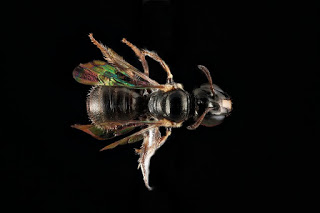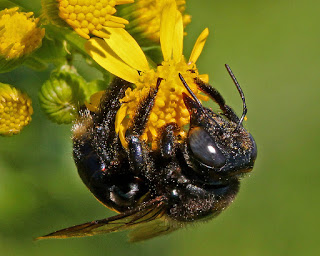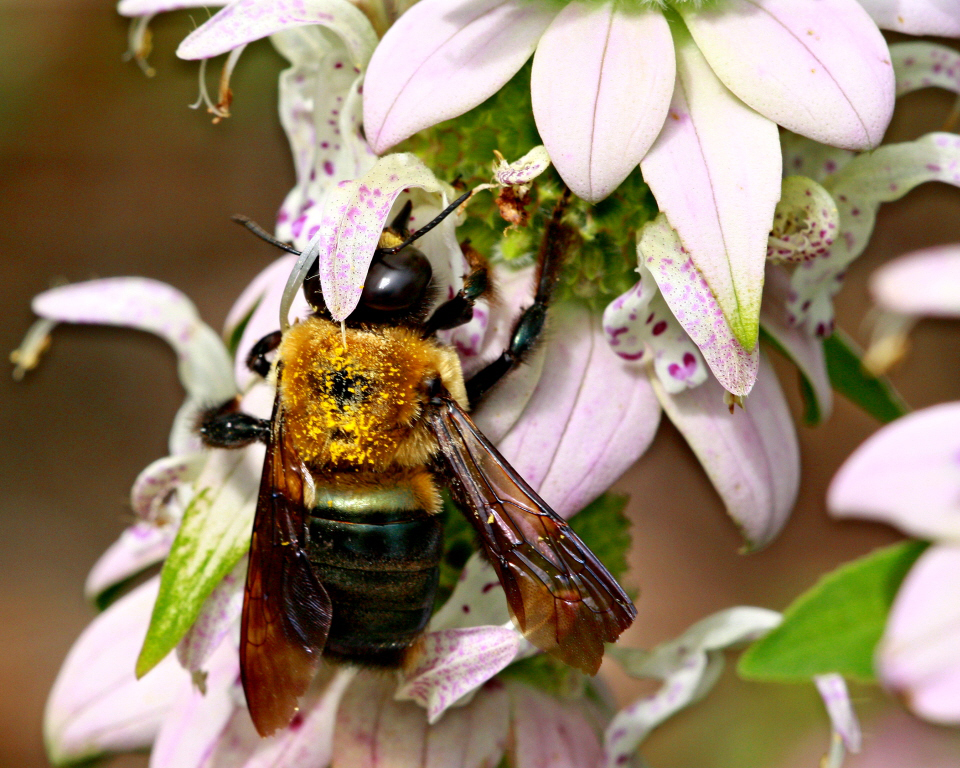Carpenter bees
by Claudia Larsen.
“Know your native pollinators” is a series of articles that will help you identify and appreciate Florida’s varied pollinators, including bees, wasps, butterflies, moths, beetles, flies, birds and bats. Pictured above: Eastern carpenter bee (Xylocopa virginica) on Spotted beebalm (Monarda punctata) by Mary Keim.
Many Floridians become familiar with carpenter bees by accident. They may notice a hole that appears to have been drilled into unpainted wood around their homes with a sawdust pile beneath it. Or they might hear a buzzing sound coming from within the hole. Both are telltale signs of carpenter bees.
CLASSIFICATION
Class: Insecta
Order: Hymenoptera
Family: Apidae
Subfamily: Xylocopinae
FORAGING PREFERENCES
Carpenter bees are generalists, thus they frequent dozens of genera of Florida wildflowers, including Amorpha, Asclepias, Aster, Bidens, Coreopsis, Erigeron, Eupatorium, Euphorbia, Geranium, Helenium, Monarda, Penstemon, Polygala, Sebatia, Scutellaria, Sida, Silphium, Smilax, Solidago, Stachys, Teucrium, Tradescantia, Verbesina, and Vernonia.
IDENTIFICATION
Carpenter bees are categorized by their size. Small carpenter bees (Ceratina spp.) are less than 8 mm long, and large carpenter bees (Xylocopa spp.) are 20 mm or larger. That’s the easy way to tell them apart.
There are two species of small carpenter bees that live in Florida:
- Ceratina cockerelli is found throughout Florida and the eastern United States. It is the smallest of the species in Florida (from 3 to 4.5 mm) and is mostly black. Flower preferences include oakleaf fleabane (Erigeron quercifolius)and blue-eyed grass (Sisyrinchium rosulatum).
- Ceratina dupla floridanus is a subspecies of the species Ceratina dupla, found in the eastern United States. It is metallic blue and from 6 to 8 mm in size. Host plants are many including those in the aster and mint families.

Click here for photos and more information on how to identify small carpenter bees.
Florida also has two species (and one subspecies) of large carpenter bees:
- The Eastern carpenter bee (Xylocopa virginica) is found throughout Eastern US and North Florida. Xylocopa virginica krombeini is a Florida subspecies found from Sumter and Lake counties south to Dade County.
- The Southern carpenter bee (Xylocopa micans) is found along the coast from southeastern Virginia to Florida, and west along the gulf to Texas.

Both species are similar in size and are often mistaken for bumblebees. Their color may be black, metallic blue, greenish black, or purplish blue and may also have slight yellow pubescence on the thorax, legs or abdomen. Bee taxonomists distinguish each species by determining the distance between the eyes, the number of antenna segments, types of submarginal cells in wings, and abdomen and thorax color and pubescence.
Flower preferences include many native shrubs but also wildflowers of Aster, Bidens, Hibiscus, Monarda, Solidago, Stachys, Teucrium and Vernonia species.
Click here for photos and more information on how to identify large carpenter bees.
LIFE CYCLE
In Florida, the bees are active most of the year and may nest in February and March and again in summer months. In the wild, the bees prefer nesting in conifers such as cypress, pine or juniper. They may nest in the same area for generations.
Small carpenter bees make their homes in stems of various dead plants. Adult females sometimes overwinter in hollow stems and continue to use the same stem as a nest. (That’s another good reason to leave taller wildflowers with hollow stems to overwinter in your garden, as well!)
Large carpenter bees chew nests in wood, and can use fence posts, stumps or dead tree branches. They also use wood on houses that is not painted or varnished.
Carpenter bees can have horizontal or vertical nests, depending on the direction of the wood’s grain. Female bees will mix pollen and regurgitated nectar (“bee bread”) in the nest tube, lay one egg on it and then wall it in with a piece of chewed wood pulp; they repeat this process until six to eight eggs are laid. She will stay with the nest until the brood hatches. Newly hatched females often share the nest with their mother. This behavior is unusual among bees, in general; most female bees do not live long enough to meet and share a nest with their offspring. Large carpenter bees, however, can live up to three years.
Although carpenter bees do not usually sting, they may dart around their nests protectively or fly at humans who approach their nest. Only females have stingers, but they rarely sting unless they are provoked.
RESOURCES
- Carpenter Bees http://www.fs.fed.us/wildflowers/pollinators/pollinator-of-the-month/carpenter_bees.shtml
- Status of Pollinators in North America http://www.nap.edu/catalog/11761/status-of-pollinators-in-north-america
- Selecting Plants for Pollinators – A Regional Guide for Farmers, Landowners, Land Managers and Gardeners in the Outer Coastal Plain Mixed Province http://pollinator.org/PDFs/OuterCoastal.rx5.pdf
- Pollination: Plants for Year-round Bee Forage http://www.ent.uga.edu/Bees/pollination/plants-year-round-forage.html
- Pollinator Plants: Southeast Region http://www.xerces.org/wp-content/uploads/2015/03/SoutheastPlantList_web.pdf
- Lee-Mäder, Eric. Attracting Native Pollinators: Protecting North America’s Bees and Butterflies: The Xerces Society Guide. North Adams, MA: Storey Pub., 2011. Print.
- Mitchell, Theodore B. Bees of the Eastern United States, Volume 2. Raleigh, NC: Published by the North Carolina Agricultural Experiment Station with Support from the National Science Foundation, 1962. Print.

